Oil is my choice in most cases when it comes to finishing exterior wood, especially if it's a DIY project. Kreidezeit lakes are among my favorites because they stand the test of time. More than five years ago, I saw the wooden facade of a house on the shores of Lake Snagov being redone and the finish still looks great. The mixture of tung oil and flax protect the wood very well against weathering and the high pigment content ensures resistance to solar radiation.
This time we turned to Kreidezeit lazes to refinish some exterior wooden doors. The intricate carving on the surface of the oak doors and the previous finish done with linseed oil in abundance left little room for other options. It would have been difficult to totally remove the oil to safely apply a water-based exterior finish. So I stuck with the option I had thought of from the beginning - oil-based pre-colored lacquer - hoping that the process of cleaning the doors wouldn't be too difficult. Hopes dashed! 🙂
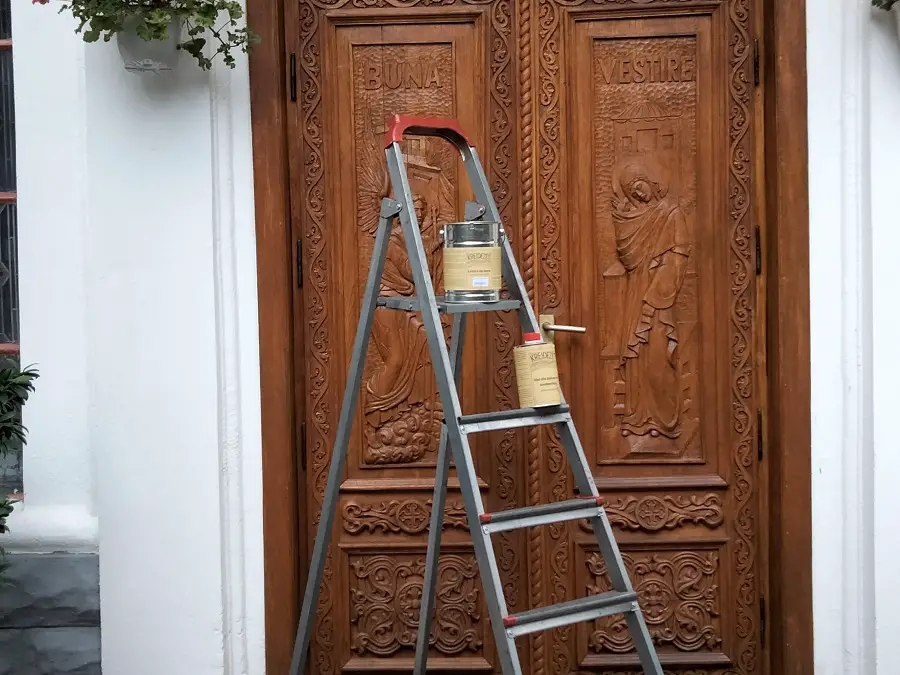
How I got into this "job"
I live near Pitar Moș Street, where the church of the same name is located. It is a small and very old church, built in the late 18th century. The totally misguided renovation before 1989 damaged much of the mural painting, which resulted in it not being included in the national heritage. The restoration work on the small church was therefore difficult and often wrong.
Fortunately, for more than 15 years the church has had a parish priest who is determined to bring the church back to its former "glory". He has fought hard, he has talked to everyone trying to build a community around the church to support his efforts. And he succeeded. The process started many years ago and in the meantime the pews have been rebuilt, the interior and exterior painting has been redone, architectural lights have been installed. The appearance of the church has changed a lot for the better, which is entirely due to him.
Now it was the turn of the carved oak doors, the double ones at the front and a single one at the entrance to the altar. Knowing what my specialty is, he asked if I could help. I started looking for someone to do the work, but it was impossible to find a craftsman willing to take on such a small job. So I turned to a very good friend who was very good at working with finishing materials and suggested that we redo the doors together. And so the adventure began.

What materials and working method we chose for cleaning oak wood
The first step was to see the actual condition of the doors, the steps and method of work and to get the necessary materials. The doors looked pretty good in terms of wood integrity, but were very dirty and loaded with gummy oil. They had been abundantly treated annually with linseed oil without, however, wiping off the excess. Linseed oil is not one of those products that can be applied in large quantities to form a film. In a thick layer it never dries, forming a very sticky gummy mass that traps all the dust and dirt in the atmosphere. This explains their very dirty appearance.
The next step was to see how to remove the dirt and oil gum. The first thought was detergent and water, but the method was unsuccessful due to the thick coating. Sanding with a sandpaper disk didn't work either, as the paper immediately loaded. A very good solution would have been baking soda blastingbut funds did not allow it. So we decided to use paint stripper, followed by thinner and sanding.
The last step of the preparations - the necessary materials (which we bought from a DIY store, except for the paint and thinner):
- Paint stripper. As the information on their effectiveness was conflicting, we decided to go with 3 types and see which one gave the best results. We used Decanol Super/Policolor, Dekapant Gel/Kober and Universal Extra Strong/Supralux Universal Paint Remover.
- Sanding paper rolls that we used on the drill
- Wire brushes
- Coarse, medium and fine abrasive sponges
- Brushes.
I've also used plastic containers, wooden stirrers and cotton cloths. The best wiping cloths are old t-shirts. This time, however, I made them out of an old tablecloth and they absorbed very well without leaving lint.
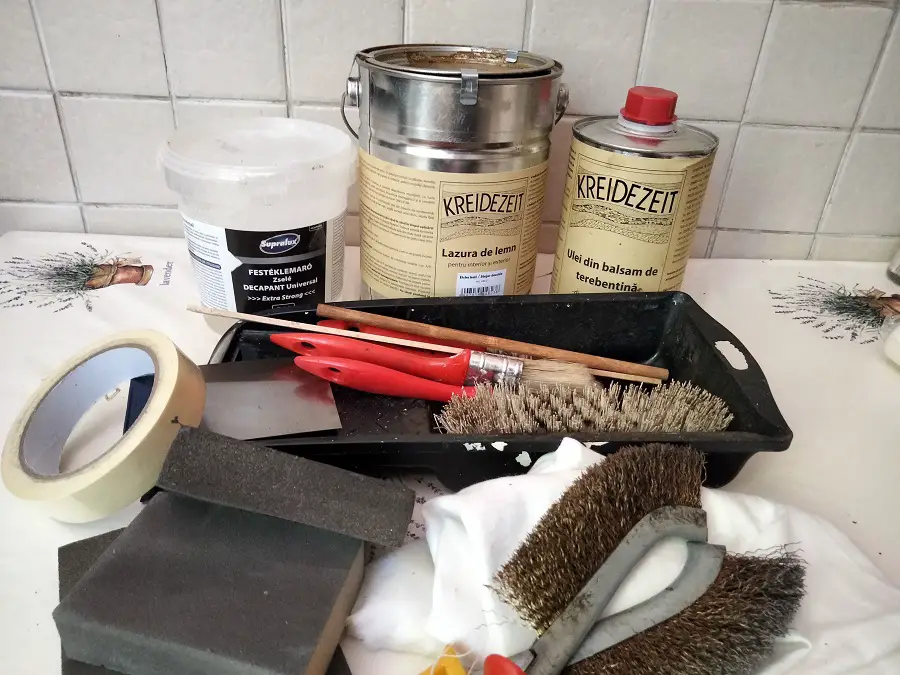
Why cleaning the wood was difficult and how we managed to remove the thick layer of oil
To clean the thick, gummy linseed oil layer, I applied the paint stripper with a paintbrush and after 20 minutes began removing the soaked layer with a wire brush. The process was difficult, especially because of the carving that adorned the entire surface of the doors. I was having a hard time getting to the areas on the second plane, and quickly gave up using the sandpaper roller for fear of ruining the carving. I stuck with the wire brush, easier to control.
Another problem was loading the wire brushes with gummy oil taken from the door, which quickly rendered it unusable. Having several, however, we were able to leave the clogged ones in the thinner to clean, during which time we would advance using a clean brush. For cleaning, we used acetone and washing up thinner, aggressive enough to make the brush usable again.
Of the three strippers used, by far the best was Supralux extra strong. It worked deep so we didn't have to go back several times to completely remove the old oil. I also had satisfactory results with Kober brand paint stripper, the worst being Policolor's Decanol. At the end, regardless of the stripper used, I "washed" the surface with thinner. I used a professional washing thinner, due to the high acetone content which makes it more effective. The washing was done with a brush to get into the most difficult places. In the end the surface was clean, free of oil gums and not sticky like it was after stripping.
Cleaning the doors of the old, gum turned oil was the most difficult part of the job. When protecting the wood with linseed oil, the excess oil left unabsorbed MUST be wiped off. Otherwise it will turn into a gum which retains all the dirt in the atmosphere and quickly spoils the appearance of the protected object.
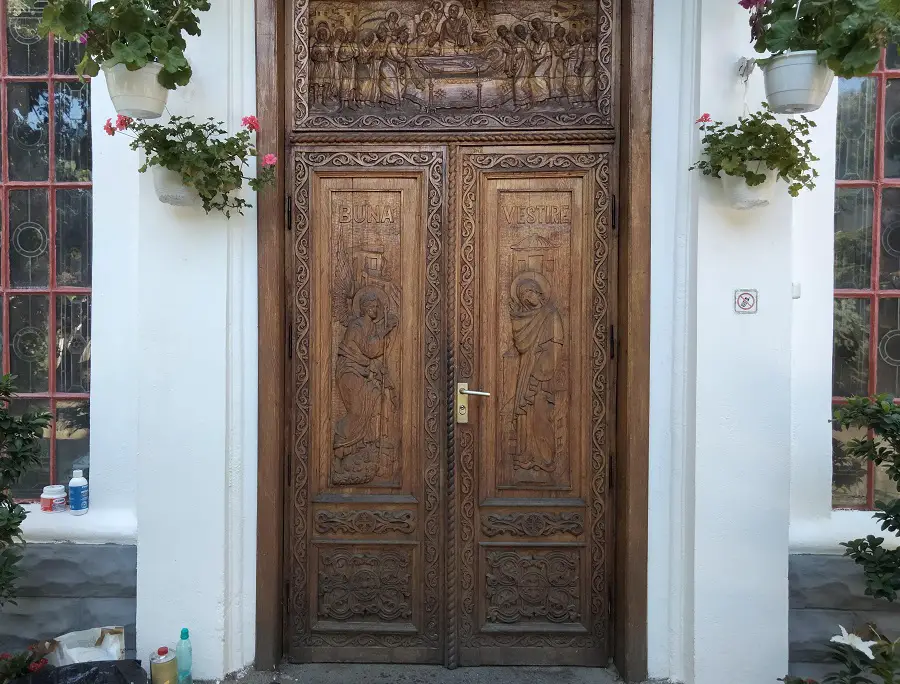
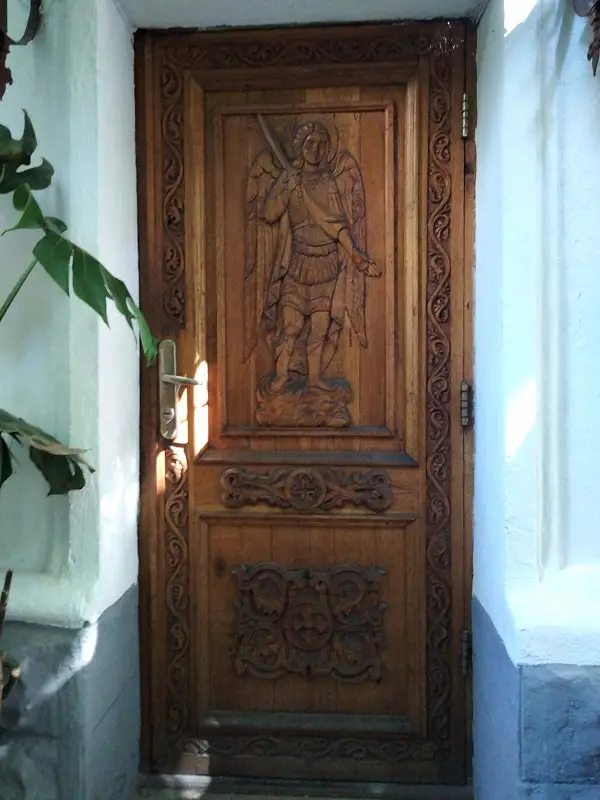
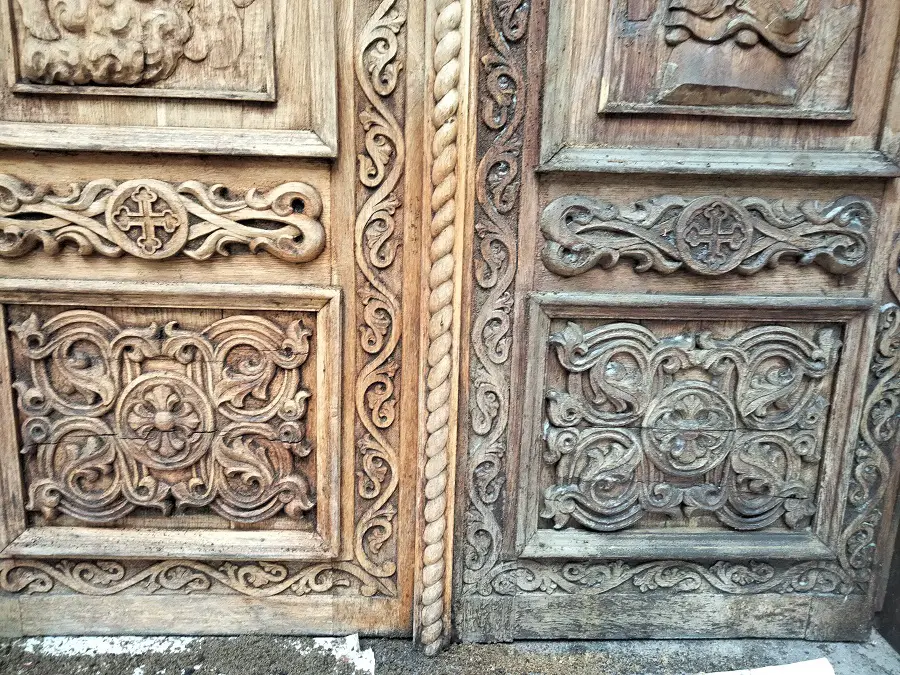
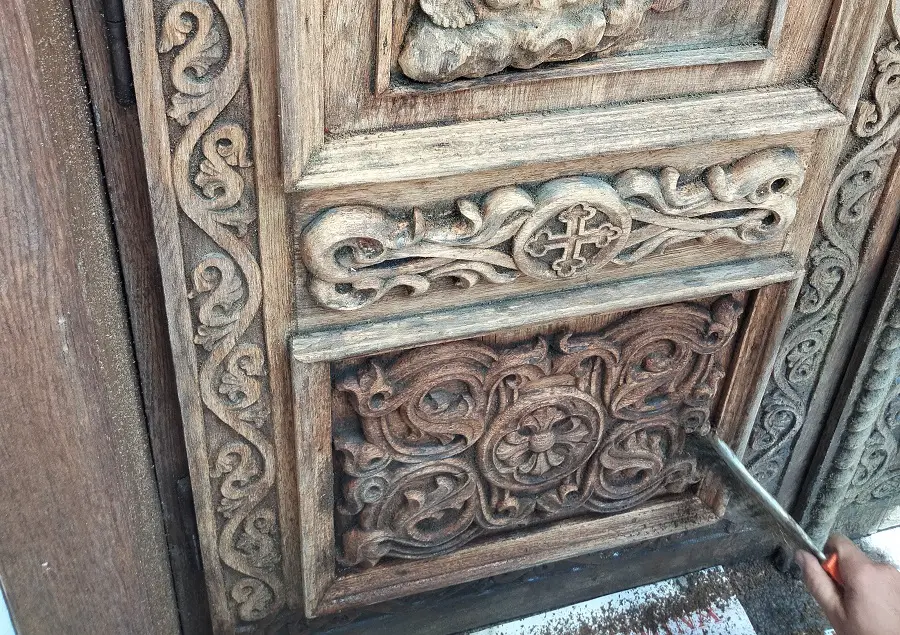
Finishing with Kreidezeit lazure
After removing the old layer of oil and washing the surface with thinner I sanded the entire surface with a medium abrasive sponge. The surface became pleasant to the touch without being very smooth, so it was able to absorb the grease. After wiping off the wood dust with the rag, we started applying the Kreidezeit varnish pre-colored light oak with a brush, a color very suitable for the solid oak doors of the church. The application was done in excess and after 45 minutes, during which time the wood had absorbed as much as it needed, I wiped the entire surface with a clean cloth, insisting on the carved areas so as not to leave any hidden oil.
The minimum drying time for lacquer is 24 hours, but we left it longer than that. It's not a problem if you leave it longer, the problem is if you apply the second coat before the first is completely dry. We left longer because it has been a very hot few days, making it difficult and risky to apply the oil in the heat.
After the very hot days passed, we resumed work. The second coat of lacquer was also needed for good resistance over time. In order not to darken the color of the doors too much, we decided that the second coat would be a colorless varnish. The first coat provided enough color to protect the doors from the sun's rays, especially since they were not directly exposed. The back door is almost never "seen" by the sun, and the front doors, in addition to the protection provided by the tall trees in the yard, have an awning for extra protection.



I applied the colorless varnish the same as the colored varnish, with the brush, in excess, then wiped the unabsorbed oil from the wood with a clean rag. The waiting time was also 45 minutes. The result was a beautifully colored surface, nice to the touch and most importantly, clean.
ATTENTION! Oil residues, soaked rags and sponges can burn themselves, especially on very hot days and in direct sunlight. This is due to the volatile oils in the solvent. To prevent any problems, all debris should be placed in empty oil containers and covered with water. Used tools should be washed well with thinner, then wiped well or soaked in water. We also put all used rags in the empty containers and covered them with water.
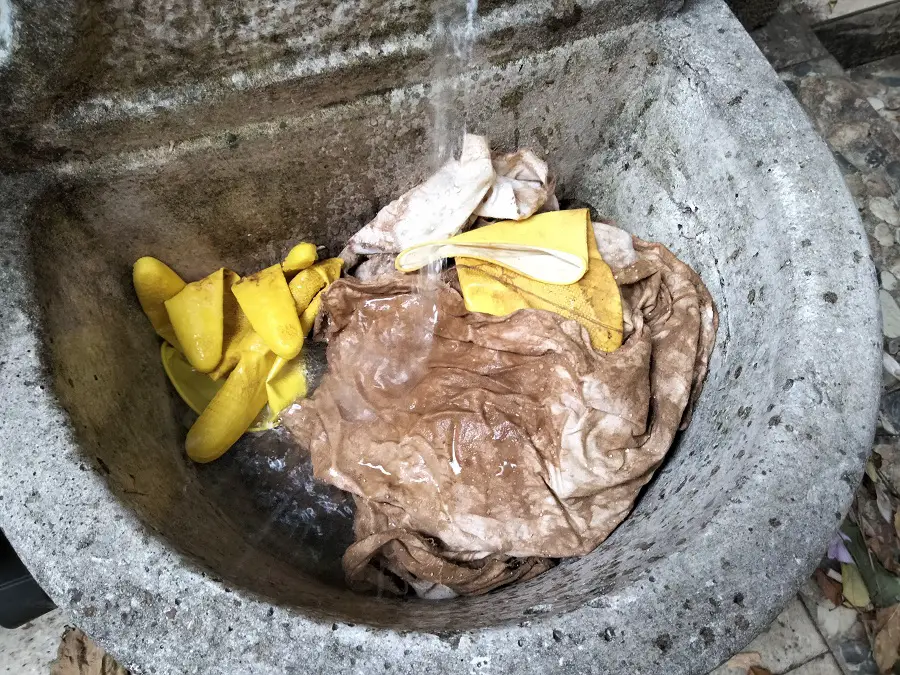
In conclusion
Now the doors of Pitar Moș church are looking good again. After the whole process we were left with a feeling of good that we were able to do this, but also with some conclusions:
- The oil should not be left in excess unless the manufacturer recommends it (there are hardener oils that form a film). Natural oils generally do not form a visible film like varnishes, and the excess that is not wiped off does not dry, but turns into a sticky, gummy surface that attracts dirt and dust.
- Oil turned into gum is very difficult to remove, especially if the surface is not flat. It quickly clogs sandpaper and wire brushes, rendering them unusable. The most effective solution was stripping followed by wiping the surface with thinner.
- The paint strippers used had different strengths, the most effective being the extra strong, Supralux brand.
- For best resistance over time, the oil-based varnish is applied in excess, left on the wood to absorb well, then wiped off. Apply a minimum of 2 coats. At least one of them must have pigment content (semi-transparent coloring) to ensure that the finish is also UV resistant.
- Leftover oil and soaked rags or sponges should be placed in containers with water and covered as they may burn.
I will track the behavior of the doors over time and do maintenance to extend the life of the finish as much as possible. As soon as their appearance becomes duller, without the specific sheen given by the oil, I will apply another coat of varnish. The lack of sheen is a sign that precipitation has "washed out" the oil, and to maintain water resistance, another coat must be applied. At that point the refinishing will be simple, without stripping and sanding, because now I have applied the materials correctly, respecting the working technology.

I hope you find the information interesting. If you have any queries or would like further information, please leave your questions below in the space provided. I will be sure to answer them.
























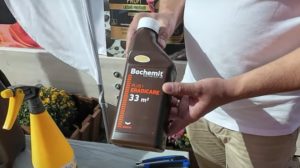
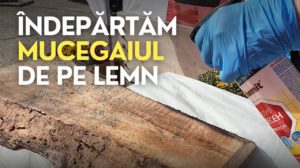







You've done a beautiful job. God bless you. God help you.
Bravo!
The doors look great.
Thanks also for the recommendations of materials and procedures.
Hello!
Congratulations for your involvement and result!
I would like some advice, if possible, please! I rescued (I say this because, if I hadn't bought it, it would have ended up in the trash) a cupboard worked in the white-white-west style. It was painted with white paint (I don't know what kind). How could I clean it from the paint, without damaging the wood and all that handmade "embroidery"?
Thank you in advance for your answer!
Hello!
Thanks for your appreciation!
Options for cleaning old paint are sandblasting, sanding, stripping or burning. Sandblasting has the best results, but it is expensive and must be done by someone who knows how to sandblast wood. Sandblasting wood is done with baking soda, dry ice, nutshell crackers, and other such softer materials.
The most handy and safe option in your case is to use a paint stripper. Below is a link to an article in which I describe the procedure in detail. I also leave a link to articles about methods of cleaning old paint layers.
Good luck!
https://revistadinlemn.ro/2022/09/08/cum-sa-cureti-cu-decapant-straturile-vechi-de-vopsea/
https://revistadinlemn.ro/2017/09/15/cum-se-curata-stratul-vechi-de-vopsea/
https://revistadinlemn.ro/2021/09/16/lemnul-innegrit-de-vreme-sau-straturile-vechi-de-vopsea-se-pot-curata-prin-sablare-atentie-insa-la-riscuri/
https://revistadinlemn.ro/2020/12/03/ce-trebuie-sa-stii-daca-vrei-sa-cureti-prin-sablare-vechiul-strat-de-vopsea-de-pe-usile-de-lemn-sau-mobilier/
Hello!
All the appreciation for the (quite hard) work you put in, with magical effect, because the end result is wonderful!
Now I ask you with a tip on how I can at amateur level (without much knowledge), renovate the doors inside the apartment!
The doors in question are made of fir wood, varnished with clear varnish more than 25 years ago. They're not great but they're still wood and I don't want to replace them with some (quite expensive) plastic "sawdust" ones.
Worse is the fact that they have some gaps between the door plates that need to be repaired (filled). Now the doors have a very light yellowish wood look, and want a darker shade.
Please with a little patience explain what and how are the steps to follow in what I have to do!
Thank you in advance!
Hello!
Thanks for your appreciation!
The steps to follow are:
- The doors are cleaned down to the wood. There are several methods of cleaning, the easiest I find with paint stripper. You have below a link to an article where it is explained at length how to do it.
- it fixes defects that have appeared over time: scratches, dents, dents, holes. Fine scratches and dents are repaired by sanding the surface with 100-grit sandpaper, then 150 or 180-grit sandpaper to make it smooth again.
The gaps between the pads may have arisen due to the very low humidity inside. It happens in houses heating with radiators, it's a dry heat (I leave below a link with detailed explanation). This is why it is recommended to put pots of water on the radiator. If this is the case, you don't need to do anything. The door will recover in the spring when it stops heating up inside and the humidity evens out. If the tiles are in the frame, they should NOT be glued to it because they will crack. They need to be able to move in the frame precisely to allow for the movement generated with the moisture variation.
If the gaps are permanent (they don't just appear in winter) and don't come through the door, they need to be grouted. Use wood putty, it can be found in any DIY store. Put put putty in the gap that has appeared, excess, let it dry, then sand to bring it to the level of the door. You have the process described at length in the link below.
If the space is pierced (you can see through the door), wooden wedges will have to be glued in place.
- sand the entire door with 150 or 180 grit sandpaper along the grain. Dust thoroughly with cloth.
- apply 2 coats of water-based varnish. Available in DIY stores.
Wood and varnish yellow over time, especially resinous wood and nitrocellulose varnish (as I believe was on the door). Water-based varnish yellows much less.
I hope this has been helpful.
Below are the links we talked about.
Good luck!
https://revistadinlemn.ro/2022/09/08/cum-sa-cureti-cu-decapant-straturile-vechi-de-vopsea/
https://revistadinlemn.ro/2021/11/10/usile-sunt-prea-colorate-cum-pot-indeparta-lacul-fara-sa-slefuiesc-si-de-ce-este-lemnul-asa-putin-vizibil-desi-a-fost-doar-lacuit/
https://revistadinlemn.ro/2017/01/11/lemnul-si-obiectele-din-lemn-timpul-iernii/
https://revistadinlemn.ro/2018/11/13/chit-de-lemn-cum-se-foloseste-tipuri-de-chit/
https://revistadinlemn.ro/2020/10/29/ce-trebuie-sa-stii-daca-vrei-sa-revopsesti-mobila-sau-usile-de-lemn/
https://revistadinlemn.ro/2020/04/23/vopsirea-si-lacuirea-sfaturi-pentru-incepatori/
Very nice! I decided to use this lacquer for my wooden garden shed, following your recommendations. The floor of the cottage is osb, what can I use for it? Thanks in advance!
From the Kreidezeit range you can use hard floor oil and a floor wax coating.
Or you can apply 2 coats of water-based floor varnish. Apply with a trowel and protect well. Find such varnishes in DIY stores.
Good luck!